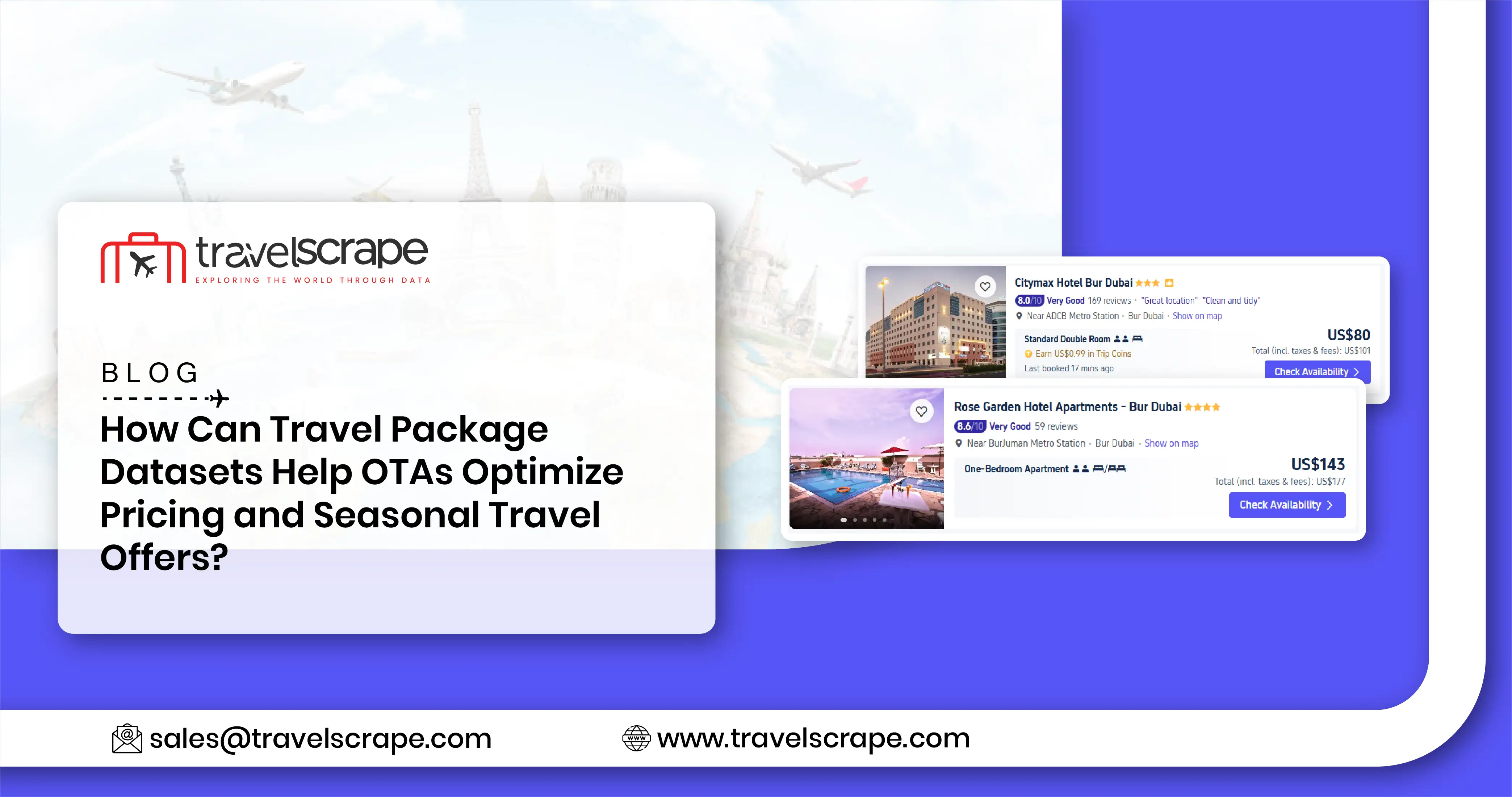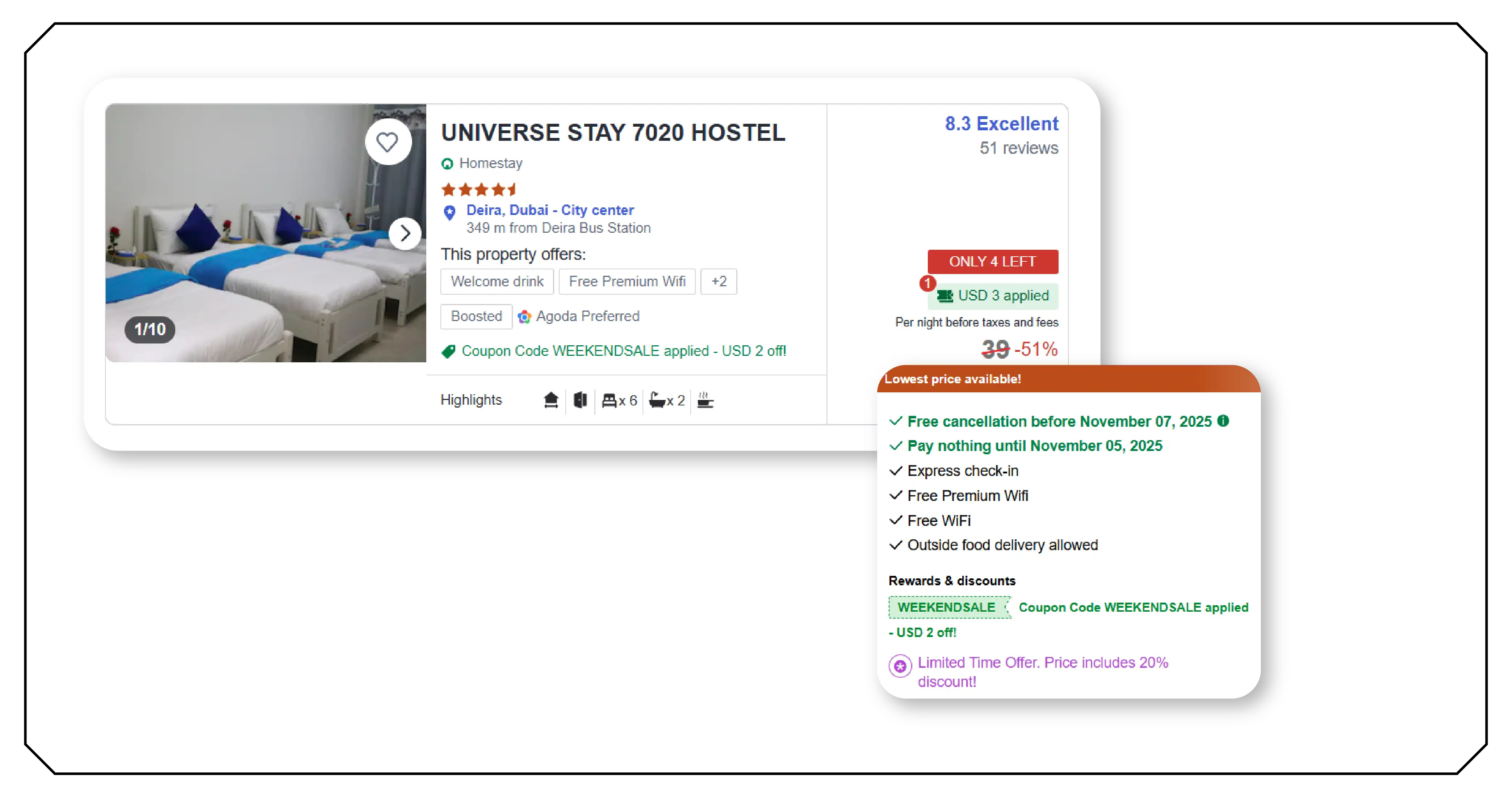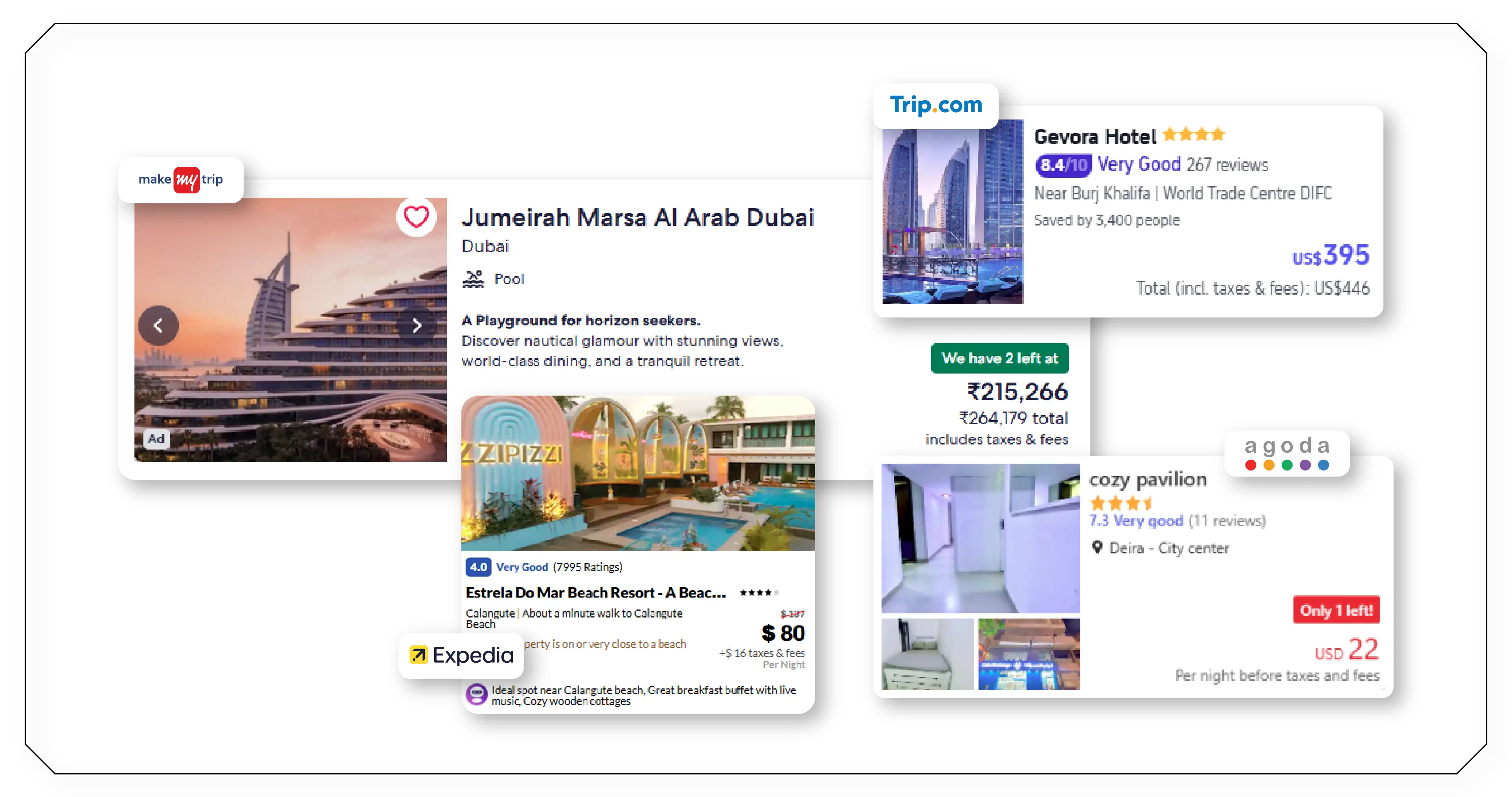How Can Travel Package Datasets Help OTAs Optimize Pricing and Seasonal Travel Offers?

Introduction
The travel and tourism industry thrives on data. Every hotel listing, flight deal, or package tour tells a story about consumer behavior, market trends, and seasonal demand. As digital travel platforms continue to expand their offerings, the ability to interpret this data accurately becomes a competitive advantage.
Scraping and analyzing travel package data from online platforms provides powerful insights into pricing strategies, destination popularity, and travel trends—essential for travel agencies, OTAs, and analysts.
By leveraging Travel Package Datasets, companies can understand how pricing, inclusions, and availability vary across seasons and regions. Meanwhile, broader Travel & Tourism Datasets help reveal macro-level patterns such as post-pandemic recovery rates, destination popularity shifts, and competitive positioning among travel providers.
With well-designed travel package data scraping techniques, businesses can transform unstructured listings into actionable insights, fueling smarter decision-making and personalized offerings.
Why Scraped Travel Package and Listing Data Matters?

In an industry driven by competition and dynamic pricing, scraped data offers unparalleled visibility. Travel platforms like Expedia, MakeMyTrip, Trip.com, and Agoda update their listings constantly to reflect real-time pricing, changing availability, and promotional offers. By collecting and analyzing these datasets, businesses can identify trends that would otherwise remain hidden in fragmented online listings.
Scraped travel package data gives stakeholders the power to:
- Benchmark their offerings against competitors.
- Monitor seasonal fluctuations and price elasticity.
- Detect demand surges linked to holidays, festivals, or global events.
- Optimize package composition—such as duration, inclusions, and destinations—to maximize conversions.
Ultimately, data-driven travel businesses can improve their profitability while offering customers better value and more relevant travel experiences.
Collecting Packages from Expedia, MakeMyTrip, Trip.com, and Agoda
Major online travel agencies (OTAs) like Expedia, MakeMyTrip, Trip.com, and Agoda are treasure troves of market intelligence. Each platform represents a diverse audience, destination focus, and pricing model. Collecting data from these sources provides a holistic view of the travel ecosystem.
1. Expedia
Expedia aggregates vacation packages, flights, and hotels globally. Scraping Expedia
package data helps uncover pricing across geographies, popular destination combinations,
and travel durations. Businesses can also track last-minute deal frequency, discount
trends, and supplier-level price variations.
2. MakeMyTrip
A leader in the Indian market, MakeMyTrip offers packages tailored to domestic and
international travelers. Extracting package data from this platform reveals insights
into seasonal pricing for destinations like Goa, Dubai, or Thailand, and provides
visibility into Indian traveler behavior patterns, such as preferred trip lengths and
hotel categories.
3. Trip.com
Trip.com’s extensive Asian market coverage makes it invaluable for analyzing regional
travel demand. Data collected from Trip.com highlights travel patterns influenced by
public holidays, flight prices, or visa regulations, helping businesses understand how
Asia-Pacific tourism dynamics evolve seasonally.
4. Agoda
Famous for its accommodation-based packages, Agoda’s data is critical for understanding
the relationship between hotel pricing and package value. Scraping its listings reveals
how accommodation quality, user ratings, and location influence package prices and
booking trends.
When combined, these four data sources create a complete picture of the global travel marketplace—empowering brands to adapt pricing, refine product offerings, and align marketing strategies with consumer expectations.
Comparing Pricing, Duration, and Seasonal Trends

Scraping package data is not just about collecting prices—it’s about interpreting the story those prices tell. Comparing attributes like package pricing, duration, inclusions, and seasonal shifts helps analysts identify where value lies and how demand evolves.
1. Price Comparison Across Platforms
Through comprehensive Travel package price comparison data, businesses can observe how
identical destinations or similar itineraries are priced differently on multiple OTAs.
For example, a 7-day Paris trip might be $1,200 on Expedia but $1,050 on Agoda due to
vendor partnerships, flight options, or room types. These differences can help travel
providers adjust their margins, improve competitiveness, or target different customer
segments.
2. Duration-Based Pricing Trends
Shorter packages (3–4 days) often have a higher per-day cost compared to longer ones
(7–10 days). Scraped data can show how package duration impacts price elasticity. OTAs
and agents can use these insights to design flexible packages that balance affordability
and perceived value.
3. Seasonal Pricing Analysis
Seasonality plays a huge role in travel pricing. Using Tour & Travel Package Data
Scraping Services, companies can detect price surges during peak travel seasons—such as
summer in Europe or winter holidays in the Alps—and optimize their pricing accordingly.
For instance, analyzing average package rates for December in Switzerland may show a 40%
increase compared to September.
4. Demand-Driven Variations
During special events like Oktoberfest in Germany or cherry blossom season in Japan,
package prices spike due to limited supply and high demand. By scraping and analyzing
these patterns, businesses can anticipate such trends and plan ahead—either by offering
early-bird deals or promoting alternative destinations.
5. Competitor and Channel Comparison
Scraped data also reveals how competitors structure their offerings. Do they include
guided tours? Meals? Airport transfers? These small differences can make a big impact on
conversion rates. Platforms that continuously monitor competitor packages gain a sharper
understanding of what attracts customers most.
Using Structured Datasets for Research and Predictive Analytics
Once data is scraped, the next step is transformation—turning unstructured web listings into structured datasets suitable for analytics and forecasting. Structured Travel Package Datasets typically include fields like:
- Destination and itinerary details
- Duration and departure cities
- Package inclusions (meals, transfers, activities)
- Seasonal availability
- Price range and discounts
- Rating and review count
- Platform or vendor information
These structured datasets are goldmines for research and predictive analytics. They enable OTAs, tourism boards, and analytics firms to uncover emerging trends, perform demand forecasting, and optimize content for better conversions.
1. Predictive Analytics for Demand Forecasting
With historical data on prices and availability, machine learning models can predict
when travel demand will rise or fall. For instance, if scraped data shows that beach
destinations like Santorini or Nice experience a consistent price hike in June, travel
companies can start promoting those packages months in advance.
2. Market Basket Analysis for Bundling Strategies
By examining which destinations or experiences frequently appear together in package
listings, OTAs can design bundled offerings that reflect traveler preferences—like
combining Rome and Venice, or Paris and Amsterdam.
3. Research on Consumer Behavior
Researchers can use Travel & Tourism Datasets to study how macroeconomic factors (like
inflation or exchange rates) impact tourism demand. Insights drawn from this data can
inform tourism policies, marketing strategies, and even sustainability initiatives.
4. Real-Time Alerts and Notifications
Integrating scraped datasets into alert systems allows OTAs to respond instantly to
competitor promotions or price changes. Automated triggers can notify teams when a
particular package drops below a target price threshold, enabling dynamic promotional
campaigns.
5. Data-Driven Content Strategy
Structured data also aids in crafting SEO-driven travel content. If data shows that
“affordable Europe tours under $800” gain traction in spring, marketers can create
campaigns around similar price points, aligning promotions with actual market demand.
The Power of Comparative Travel Intelligence
Comparing travel package data across platforms and seasons creates a foundation for Travel Data Intelligence Solutions. With the right analytical framework, travel platforms can uncover insights like:
- Which destinations show the strongest correlation between reviews and pricing.
- Which types of packages (family, adventure, honeymoon) perform best seasonally.
- How currency fluctuations affect package affordability across markets.
Data intelligence also allows OTAs to personalize recommendations based on user profiles. For example, travelers who prefer short city breaks can be targeted with 3-day packages under a certain price range, while long-term vacationers receive extended stay deals.
Additionally, integrating AI-driven models helps detect outlier trends—like unusually low prices for a luxury destination—which can signal promotional opportunities or supplier errors worth capitalizing on.
Understanding the Pricing Dynamics Behind Travel Packages
Travel pricing is a constantly shifting landscape. Airlines adjust fares dynamically, hotels vary their room rates daily, and tour operators respond to competitor actions. Scraping and analyzing package data brings transparency to this complexity.
For example, when airfare drops for a particular route, package prices often decline soon after. Conversely, when accommodation rates rise due to an event, package prices reflect that increase instantly. Tracking these dependencies through continuous Travel Package Data Scraping allows OTAs to anticipate market shifts and adjust their inventory in real-time.
Travel pricing intelligence derived from such data benefits multiple stakeholders:
- OTAs: for pricing optimization and profit margin control.
- Hotels and Airlines: for adjusting distribution strategies.
- Consumers: through improved price transparency and timely discounts.
Ultimately, the goal is to create a dynamic pricing environment that balances profitability with customer satisfaction.
Seasonal Demand and Travel Availability Insights
Seasonality has always been the cornerstone of travel demand. From ski resorts in winter to beach destinations in summer, demand fluctuations define pricing and marketing cycles. Web scraping enables travel companies to map these variations comprehensively.
1. Identifying Peak and Off-Peak Seasons
By analyzing years of package data, OTAs can pinpoint exact travel windows when demand
surges or dips. This helps in capacity planning, resource allocation, and revenue
optimization.
2. Forecasting Regional Demand
Scraped data can show how European travelers prefer Mediterranean destinations during
July–August, while Asian travelers favor domestic trips during Chinese New Year.
Understanding these differences enables global OTAs to localize offerings effectively.
3. Adjusting Inventory and Promotions
When availability data shows that certain destinations are overbooked, OTAs can push
alternative options to balance supply. Similarly, they can run promotions for less
popular months to stabilize cash flow.
4. Long-Term Demand Planning
For travel agencies, understanding multi-year seasonal patterns helps forecast staffing,
partnerships, and ad spending. For example, agencies might allocate higher marketing
budgets during the high-demand spring break or summer seasons.
Leveraging APIs and Automation for Data Scalability
Modern scraping technology goes beyond simple extraction. With scalable APIs, businesses can automate the collection, cleaning, and analysis of vast datasets from travel sites. These APIs can handle millions of listings across hundreds of destinations, providing fresh insights daily.
Automated data pipelines integrate scraped information into dashboards or analytics platforms—offering real-time visibility into pricing, package availability, and customer sentiment. This allows travel analysts to move from reactive strategies to predictive decision-making.
Furthermore, integrating external data sources like weather forecasts or event calendars enriches the predictive power of scraped travel data, giving businesses a holistic understanding of demand influencers.
Conversion Angle: Explore Sample Datasets or APIs for Testing
If you’re looking to elevate your travel intelligence strategy, it’s time to explore sample datasets or test Travel Scrape’s APIs. Our Tour & Travel Package Data Scraping Services allow you to access structured, reliable, and real-time data feeds from platforms like Expedia, Agoda, and Trip.com—tailored to your unique business goals.
With these APIs, you can:
- Analyze thousands of listings instantly.
- Compare package prices across competitors.
- Identify trending destinations before they peak.
- Build predictive dashboards for travel pricing and availability.
Whether you’re an OTA, data scientist, or tourism consultant, testing our sample datasets gives you hands-on experience with data-driven travel insights. Discover how Travel Scrape transforms raw travel listings into valuable intelligence that drives smarter pricing, better marketing, and stronger revenue outcomes.
How Travel Scrape Can Help You?
- Comprehensive Data Collection: Gather real-time travel package details, including prices, itineraries, and inclusions from leading platforms like Expedia, MakeMyTrip, Trip.com, and Agoda.
- Competitive Pricing Insights: Compare package costs, durations, and offers across multiple OTAs to identify pricing gaps and competitive opportunities.
- Seasonal Demand Forecasting: Analyze historical and current data to detect peak booking periods and forecast future travel demand patterns.
- Custom Dataset Delivery: Receive structured Travel Package Datasets tailored to specific destinations, travel types, or customer segments for precise analytics.
- Actionable Market Intelligence: Transform large-scale scraped data into insights that support smarter pricing, promotions, and strategic business decisions.
Conclusion
In a world where consumer preferences shift overnight, having real-time visibility into travel data is no longer optional—it’s essential. By continuously scraping and analyzing travel package listings, companies can stay ahead of market trends, adjust to pricing fluctuations, and deliver superior customer experiences.
The integration of Real-time travel package availability Extract ensures that OTAs and agents remain updated on every pricing movement, cancellation, or promotion. This immediacy, combined with historical trend analysis, offers the precision needed to optimize decisions at every level of the business.
Furthermore, the potential of Travel Package trend data extraction extends far beyond pricing. It opens doors to deeper market understanding, refined marketing campaigns, and strategic growth in both local and global markets.
As travel becomes more data-centric, the ability to perform web scraping seasonal demand Travel Package analysis becomes the defining skill for any OTA, travel consultant, or data analyst. With accurate datasets and intelligent automation, your business can navigate the complex travel ecosystem confidently—turning every dataset into a strategic advantage.
Ready to elevate your travel business with cutting-edge data insights? Scrape Aggregated Flight Fares to identify competitive rates and optimize your revenue strategies efficiently. Discover emerging opportunities with tools to Extract Travel Website Data, leveraging comprehensive data to forecast market shifts and enhance your service offerings. Real-Time Travel App Data Scraping Services helps stay ahead of competitors, gaining instant insights into bookings, promotions, and customer behavior across multiple platforms. Get in touch with Travel Scrape today to explore how our end-to-end data solutions can uncover new revenue streams, enhance your offerings, and strengthen your competitive edge in the travel market.